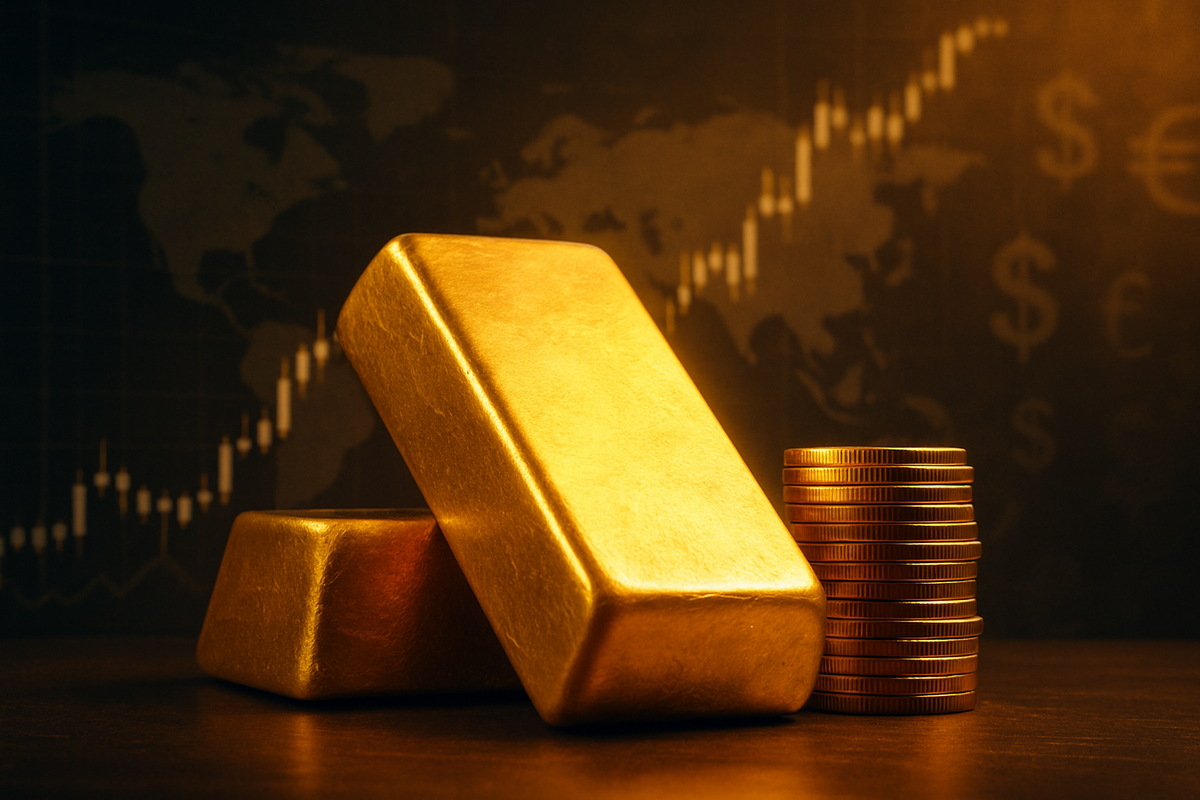
New York, NY – October 15, 2025 – Gold prices witnessed a momentous surge today, climbing over 1% to breach the $4,200 per ounce mark, establishing a fresh all-time high. This remarkable ascent, reported by financial outlets like Benzinga, signifies gold's 13th gain in the past 15 trading sessions, capping its best year since 1979 with a staggering 60% year-to-date increase.
The precious metal's rally is largely attributed to a powerful confluence of factors: growing expectations for aggressive Federal Reserve interest rate cuts, persistent inflation concerns, escalating geopolitical tensions, robust central bank buying, and a weakening U.S. dollar. This perfect storm has firmly re-established gold's traditional role as a safe-haven asset and an inflation hedge in an increasingly uncertain global economic landscape.
A Golden Resurgence: Unpacking the Drivers of Today's Historic Climb
Today's trading saw the spot price of gold hover between $4,200 and $4,217.50 per ounce, reflecting a significant daily gain. This substantial move was mirrored by silver, which also saw a sharp increase, boasting a 2.2% gain to reach $52.50 per ounce. While precious metals soared, U.S. stock markets, including the S&P 500, Nasdaq, and Dow Jones, also traded higher, buoyed by strong bank and corporate earnings reports and the overarching sentiment of impending rate cuts. In contrast, Bitcoin experienced a 2% slide, trading around $110,000.
The pathway to this historic high has been paved by a series of events and trends stretching back over the past few years. Persistent geopolitical instability, including ongoing conflicts in Ukraine and the Middle East, coupled with political transitions and trade tensions in major economies, has consistently bolstered gold's appeal as a safe harbor. Simultaneously, stubborn inflation has remained above the Federal Reserve's 2% target for over four years in the U.S., driving investors to seek gold as a reliable store of value. A multi-month decline in the strength of the U.S. dollar has further enhanced gold's attractiveness to international buyers, making it more affordable in other currencies.
Crucially, the market is now fully pricing in a 25-basis-point Federal Reserve rate cut in October, with a 95% probability of another reduction in December. These dovish expectations have significantly reduced the opportunity cost of holding non-yielding assets like gold. Adding to the demand, central banks worldwide have engaged in aggressive gold accumulation throughout 2025, continuing a multi-year trend of diversifying reserves away from traditional currency holdings, thereby creating consistent upward pressure on gold prices. This institutional buying, combined with the "Great Debasement Trade" sentiment reflecting concerns over fiat currency stability, underscores a profound shift in global financial strategy.
Corporate Fortunes: Winners and Losers in the Gold Rush
The dramatic surge in gold prices creates a clear divide in corporate fortunes, directly benefiting companies involved in gold mining and precious metals, while posing challenges for others.
Gold Miners and Precious Metals Companies stand to be the primary beneficiaries. Firms such as Newmont (NYSE: NEM), Barrick Gold (NYSE: GOLD), Agnico Eagle Mines (TSX:AEM, NYSE: AEM), AngloGold Ashanti (NYSE: AU, ASX:AGG), Gold Fields (NYSE: GFI), Kinross Gold (TSX:K, NYSE: KGC), Freeport-McMoRan (NYSE: FCX), Alamos Gold (TSX:AGI, NYSE: AGI), Coeur Mining Inc (NYSE: CDE), Iamgold Corp (NYSE: IAG), B2gold Corp (NYSE: BTG), Equinox Gold Corp (NYSE: EQX), and Centerra Gold Inc (TSX:CG) are expected to see substantial increases in revenue, profitability, and stock performance. These companies often exhibit operational leverage, meaning their production costs remain relatively stable while revenues multiply with higher gold prices, leading to significantly expanded profit margins. For instance, in previous periods of rising gold, miners have reportedly retained approximately 58% of gold price gains as pure profit, with profit margins expanding at nearly twice the rate of the gold price increase. This is reflected in the strong year-to-date gains for the VanEck Gold Miners ETF (GDX) and individual companies like Newmont, which have seen share price increases amplifying gold's parallel upside.
Precious metals streaming and royalty companies, including Wheaton Precious Metals Corp (NYSE: WPM), Franco-Nevada Corporation (NYSE: FNV), and Osisko Gold Royalties (TSX:OR, NYSE: OR), are also poised for exceptional gains. These companies provide upfront financing to miners in exchange for future production at a fixed, lower cost. A gold price surge directly translates into increased cash flows for them, as the widening spread between their fixed purchase price and the soaring market price significantly boosts their profitability without bearing direct operational mining risks. The elevated prices also incentivize miners to boost production and exploration, further benefiting these companies.
Conversely, the economic conditions driving gold's rise can create headwinds for other sectors. Multinational corporations that report earnings in a weakening U.S. dollar may see their foreign revenues diluted. Import-reliant businesses, such as car dealerships selling imported vehicles or retailers sourcing foreign goods, will face increased operational costs due to the depreciating dollar, potentially leading to higher consumer prices and reduced spending. Certain financial institutions, including large banks like JPMorgan Chase (NYSE: JPM) and Bank of America (NYSE: BAC), might experience compressed net interest margins (NIMs) if the yield curve flatters due to anticipated interest rate cuts. The flight to safety that accompanies gold surges can also divert investment away from high-growth technology and speculative investments, which typically thrive in periods of economic optimism. Furthermore, traditional long-term bonds and growth stocks tend to underperform during periods of high inflation and weak economic growth, which are often the very catalysts for gold's ascent.
Broader Implications: A Shifting Global Financial Landscape
The current gold surge is not an isolated event but rather a significant indicator of broader shifts within the global financial landscape. It underscores gold's enduring role as the ultimate safe-haven asset, particularly during times of heightened economic uncertainty and geopolitical instability. The "Great Debasement Trade" narrative—a growing concern about the long-term stability and purchasing power of fiat currencies—is gaining traction, pushing more investors towards tangible assets like gold. This trend is further amplified by the extraordinary levels of gold accumulation by central banks globally in 2025, a clear move to diversify reserves and de-risk from traditional currency holdings, especially the U.S. dollar.
This event also fits into a broader phenomenon often termed the "Everything Rally," where several major asset classes have seen strong performance in 2025. While this might seem counterintuitive with a flight to safety, it suggests a market awash with liquidity and a hunt for value across various segments, where gold retains its perceived value as a hedge. The Federal Reserve's anticipated rate cuts, driven by persistent inflation and a potentially cooling labor market, signal a significant shift in monetary policy that has ripple effects across all asset classes. Lower interest rates reduce the opportunity cost of holding non-yielding assets, making gold comparatively more attractive.
Historically, gold has proven its mettle during periods of high inflation and geopolitical strife. The current environment, with inflation remaining stubbornly high for over four years and global tensions showing no signs of abating, mirrors conditions that have historically propelled gold to new highs. The fact that 2025 is shaping up to be gold's best year since 1979 highlights the severity of the current economic and geopolitical challenges and the market's response to them. Regulatory and policy implications are significant, as central banks worldwide continue to reassess their reserve management strategies in light of ongoing economic and geopolitical volatility, potentially leading to a more diversified global financial system less reliant on a single reserve currency.
What Comes Next: Navigating the Golden Horizon
Looking ahead, the short-term outlook for gold suggests continued volatility but with a strong underlying bullish sentiment. If the Federal Reserve proceeds with its anticipated rate cuts in October and December, and if global geopolitical tensions persist, gold could see further upward momentum. The reduced opportunity cost of holding gold in a lower interest rate environment, coupled with its safe-haven appeal, creates a fertile ground for sustained gains. However, any unexpected hawkish shift from the Fed or a de-escalation of global conflicts could introduce downward pressure.
In the long term, gold's appeal as a hedge against inflation and geopolitical risk appears firmly entrenched. The current environment may represent a structural shift in how investors and central banks view monetary policy and currency stability, cementing gold's role as a cornerstone asset. Market opportunities will likely emerge in gold-related assets, including mining stocks, gold ETFs, and precious metals royalty companies, as investors seek to capitalize on the metal's upward trajectory. Conversely, challenges may arise for those heavily exposed to traditional interest-bearing assets or fiat currencies experiencing debasement.
Potential strategic pivots for corporations might include gold miners accelerating exploration and production to capitalize on high prices, while other industries might need to reassess supply chains and currency exposure in a weaker dollar environment. Scenarios could range from a continued "everything rally" where gold maintains its strength alongside equities, to a more pronounced flight to safety if economic conditions deteriorate further, causing a broader market downturn with gold acting as a primary refuge. Investors should prepare for a dynamic market where gold's performance will be highly sensitive to macroeconomic data, central bank communications, and global political developments.
The Enduring Allure: A Comprehensive Wrap-Up
Today's historic surge in gold prices to over $4,200 an ounce marks a pivotal moment in the financial markets, reaffirming the metal's enduring allure as a safe-haven and inflation hedge. The confluence of anticipated Federal Reserve rate cuts, persistent inflationary pressures, elevated geopolitical tensions, and aggressive central bank buying has created a powerful tailwind for gold, propelling it to levels not seen before. This rally is not merely a transient spike but reflects deeper structural shifts in the global economy and investor sentiment.
Moving forward, gold is poised to remain a cornerstone asset in diversified portfolios. Its ability to perform strongly during periods of economic uncertainty and currency devaluation makes it an indispensable component for wealth preservation. The market will be closely watching the Federal Reserve's upcoming policy decisions, any new developments in global geopolitical hotspots, and the trajectory of inflation data. Furthermore, the continued trend of central bank gold accumulation will be a critical indicator of institutional confidence in the metal.
For investors, the key takeaway is the reinforced significance of gold as a defensive asset. While opportunities abound in gold-related equities and investment vehicles, a prudent approach involves understanding the underlying drivers and monitoring global macroeconomic and geopolitical developments. Gold's journey to new highs underscores a fundamental re-evaluation of risk and value in a complex world, making it a critical asset to watch in the coming months and years.
This content is intended for informational purposes only and is not financial advice






